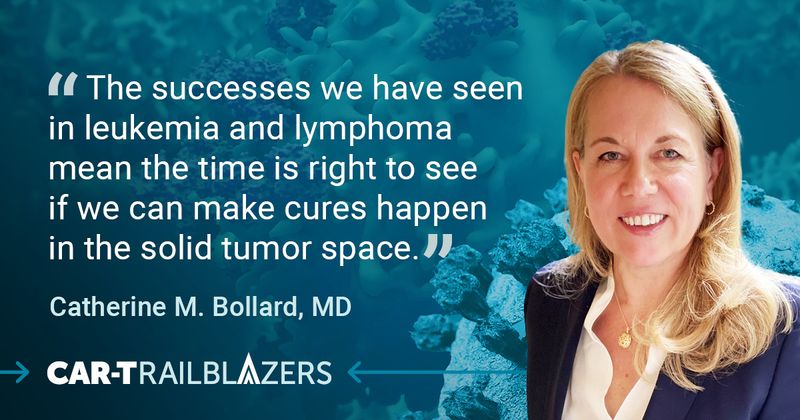Cell therapist invests in 'next generation' of treatments, scientists
If Catherine M. Bollard, MD, grows tired of her day job as a physician and world-class cancer researcher, she can always fall back on her soprano singing capabilities.
It’s likely few individuals have ever faced the choice of pursuing a career in oncology vs. one as a professional opera singer. Based on footage available on YouTube, it’s likely Bollard would have been successful even if she chose the other path.

Well before overseeing her own cellular therapy program as director of the Center for Cancer and Immunology Research at Children’s National Research Institute, Bollard — a New Zealand native — split her time between studying opera and being a resident in pediatric hematology-oncology at St. Bartholomew’s Hospital in London.
Bollard’s interest in medicine won out over her singing dreams, a decision she attributed to the passing of her best friend in high school, who developed treatment-resistant Epstein-Barr virus (EBV)-positive Hodgkin’s lymphoma.
After a long battle with the disease — including being one of the first in New Zealand to receive a bone marrow transplant — Bollard’s friend developed myelodysplastic syndrome directly attributable to previous treatments.
She died quickly thereafter from acute myeloid leukemia.
“It was really a very devastating time for me,” Bollard told Healio. “I just thought that there had to be a better way to treat cancer — to target cancer cells and not healthy ones — so that others wouldn’t suffer the same fate.”
Up for the challenge
Bollard first encountered the science of cancer cell therapy while in medical school, and it piqued her interest as a possible less toxic solution to cancer treatment.
It just so happened she had a connection to a fellow New Zealander and early career mentor, Helen E. Heslop, MD, DSc (Hon), who was working on cell therapy-based approaches in the Center for Cell and Gene Therapy at Baylor College of Medicine in the United States.
Although originally drawn to Houston for postdoc work developing vaccines for neuroblastoma, Bollard serendipitously received an offer for a spot on another project researching novel cell therapies for EBV-positive lymphoma.
“Oh my God, yes, I would love to work on that project,” Bollard recalled saying at the time. “The rest is sort of history. That was really what launched me into the field.”
Bollard was unafraid to take on tough projects from the start, according to Heslop.
“She was excited to do work on this sort of tumor,” Heslop told Healio.
Bollard accepted what Heslop called a “high-risk, high-reward project” — evaluating dominant negative transforming growth factor (TGF)-beta receptor to overcome tumor immunosuppression — that had been offered to and turned down by more than one postdoc researcher.
“Cath was the confident one who had enough interest to take this challenge on,” Heslop said. “So, she worked on validating that strategy and the resulting translation to a clinical cell therapy. I think she enjoyed it because she never went back to New Zealand.”
Bollard’s early work on novel cell therapies for EBV-positive lymphoma took place under the guidance of her mentors, which included Heslop and Cliona M. Rooney, PhD, director of the translational research laboratories at Center for Cell and Gene Therapy in Houston.
Their group published initial preclinical findings regarding a novel cell therapy comprising EBV-specific T lymphocytes transduced with a dominant negative TGF-beta receptor in 2002 and 2008.
“I initially built on the work that Helen and Clio had done in the post bone marrow transplant setting and then we refined the [cell therapy] product more so that it predominately targets the antigens that are expressed by the tumor cells,” Bollard said.
Bollard led numerous studies in this area, including preclinical validation, safety studies and the eventual first-in-human clinical trial.
A 2018 publication in Journal of Clinical Oncology showed the antigen-specific cell therapy they developed for relapsed EBV-positive Hodgkin lymphoma produced responses in four of seven patients, including two patients who have had complete responses lasting more than 10 years.
“Certainly, I do feel that the contributions we made to the field in this area have had an impact,” Bollard said. “I do believe honestly that if my friend was diagnosed today, then she would not suffer the same fate.”
Lasting contributions
Heslop said Bollard’s research continues to benefit patients, including one woman with EBV-positive disease who was treated on two of Bollard’s clinical trials and continues to remain in remission more than 12 years after receiving their novel cellular therapy.

“[Bollard] took this therapy all the way through from the bench to the bedside to the long-term follow up,” Heslop said. “It has definitely had an impact and, of course, other people are now looking at other applications for dominant negative TGF-beta receptors.”
Beyond her work in the clinic or at the research bench, Bollard’s lasting contribution to the field comes in her role as a natural team builder, Heslop said.
This skill became a prerequisite in Bollard’s next endeavor — developing her own cellular therapy clinical research program when she took a new position at Children’s National Hospital in Washington, D.C., in 2013.
She remains at that institution, serving as director of the Program for Cell Enhancement and Technologies for Immunotherapy and professor of pediatrics and microbiology, immunology and tropical medicine at The George Washington University.
Heslop described her friend and colleague as “a very extroverted, outgoing person who is highly committed to team science and mentoring.”
Bollard’s ability to collaborate with others is her greatest asset, Heslop added.
One example, Heslop said, is the Cancer Grand Challenges team Bollard has assembled with Martin Pule, MD, PhD, at University College London to apply novel cellular therapies to a greater array of diseases, including use of T cells to treat pediatric solid tumors. The team is funded by a $25 million grant from the NCI, Cancer Research UK and the Mark Foundation for Cancer Research.
Now that she has accomplished an early goal of finding a more effective and less toxic therapy for EBV-positive lymphoma, Bollard plans to use the funds to shift the focus.
“We're going after the hardest-to-treat cancers, such as acute myeloid leukemia — which is what ultimately killed my friend — but also pediatric solid tumors,” Bollard said.
“Certainly, for blood cancers, I [believe] there are patients who are cured with cell therapies,” Bollard added. “The successes we have seen in leukemia and lymphoma mean the time is right to see if we can make cures happen in the solid tumor space.”
Bollard is not afraid to take on challenging scenarios, Heslop said.
“Cath knows how to assemble a team of collaborators who have all of the expertise to take on tough projects,” Heslop said.
Bollard’s impact on training the next generation of scientists in the cell therapy field has been recognized by International Society for Cell & Gene Therapy, which awarded her with its Darwin J. Prockop Mentoring Award in 2021.
“Cath has always been highly committed to mentoring,” Heslop said. “She's mentored a lot of people — both while she was at Baylor, and even more so now that she's leading her own center in Washington.”
Bollard’s former mentees are having a positive effect across the country, not just within cell therapy but in several aspects of health care, Heslop added.
“She’s had a much broader impact, including becoming very involved in some clinical research training courses,” Heslop said. “I think she's certainly doing a lot to ensure the next generation is active in this field.”
Investing in the future
Bollard is thankful for the early guidance she received and said much of the credit for her life’s work can be attributed to those ongoing relationships.
“Helen and Clio were — and continue to be — amazing mentors,” she said. “I hadn't appreciated at the time how rare it was to have female mentorship — strong female mentorship that is selfless and really able to guide you.”
One of the most satisfying aspects of her current position has been seeing the continued contributions from the members of her team who have helped the program at Children’s National grow from a startup to a robust center in less than a decade.
It’s hard work and nowhere near a 9-to-5 job, Bollard said, so strong mentorship and investment in future leaders is needed.
“Watching this next generation of cell therapists is just an awesome experience [for] me,” she said. “I'm cognizant of the fact that, after my generation — unless we truly invest in training, inspiring and mentoring the next generation — the field won't be sustainable because of its anticipated rapid growth.”
Bollard said she feels a need to pay her experiences forward and serve as the same strong female role model for other young women in the field, while at the same time making herself available on a personal level to all who work within her program.
“One-on-one interaction is really important,” Bollard said.
“I have a boots-on-the-ground mentoring style,” she added. “I meet with my mentees one on one at least every week or two depending on their level of seniority, but everyone gets to meet with me one on one.”
Bollard makes a concerted effort to fashion a leadership style that is collaborative rather than dictatorial.
“Let’s work together on this,” she said, describing her approach. “That is really what I learned from [my mentors].”
As a team builder, Bollard has learned that nothing is accomplished alone. She said she hopes to pass along the great leadership qualities that her role models imparted throughout her career thus far.
“I have such amazing people who work with me now and who clearly believe in our vision to develop the next generation of cell therapies for our patients,” Bollard said. “It’s been quite a journey.”
References :
- Bollard CM, et al. J Clin Oncol. 2018;doi:10.1200/JCO.2017.74.3179.
- Bollard CM, et al. Blood. 2002;doi:10.1182/blood.v99.9.3179.
For more information :
Catherine M. Bollard, MD, can be reached at cbollard@childrensnational.org.
Helen E. Heslop, MD, DSc (Hon), can be reached at hheslop@bcm.edu.

